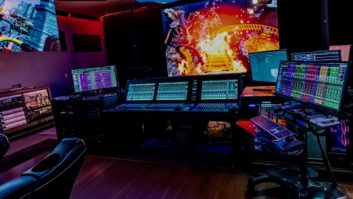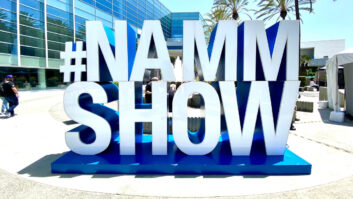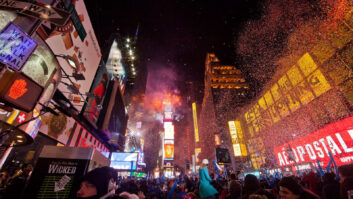When Meryl Streep and Rick Springfield began filming Ricki and the Flash, starring as aging rockers, the film’s music wrangler, Neil Citron, was appointed with a difficult task: to record the film’s musical numbers live. Pro Sound News covered this feat in its September, 2015 issue [read the story here], but there was even more to the story, including cool video clips, that you can enjoy here.
For authenticity, the production of Ricki and the Flash only had vocal mics visible during the songs performed in the scenes at the Salt Well, the film’s fictitious L.A.-area dive bar. “The only non-Audio-Technica mics were the 58s in the club,” Citron reports.
“We initially put mics in the back of the guitar amps, with direct boxes. We figured we would re-amp. But I got turned on to the greatest box ever, the Radial JDX, which has speaker emulation. The combination of that direct box—which is really not just a direct sound but sounds like you miked it, with no leakage—and the re-amp is the guitar sound.”
There is a mic on the snare drum in the club scenes, he acknowledges (and the tiny A-T mic below the hi-hat can be seen momentarily, if you don’t blink and miss it). “They put a mic on the snare because they were worried our trigger wasn’t working. We wound up using the trigger,” he says.
The overhead mics, hidden among the lights above the low stage, worked well, judging from the final mix. “The only problem was we had to filter out [Joe’s] monitor going right into the overheads,” says Citron.
Some of the songs from the Salt Well are edited together from five or six takes, he reveals. “Thankfully Joe’s got great time. He worked to a click but it was visual, because they didn’t want anything in his ear.”
The recording and live sound team—music coordinator Mark Wolfson, music wrangler Neil Citron, and PreSonus tech and FOH mixer Phil Garfinkel—were located behind the door at stage right in the club scenes, alongside Jeff Pullman, C.A.S, the film’s production sound mixer. “We called it Sound City,” laughs Citron.
“I hated to see them tear it apart,” he says of the realistic set. “It was great.”
For redundancy, the team set up two recording paths. “A friend of mine, Neil Faison, works at Tascam, and loaned me an X48 [multitrack recorder]. We wound up recording everything to both Studio1 and the X48 hard drive,” says Citron.
One path fed Garfinkel’s MacBook Pro, running Capture, and was connected to the console via FireWire. The console’s DB25 outputs fed the X48 recorder, which supports the necessary SMPTE time code. At the end of the day, Citron and Wolfson took the drives back to their rented apartment, hooked the MacBook up to the Sceptre monitors using a PreSonus FireStudio Mobile interface, and created rough mixes for the production team to evaluate.
According to Garfinkel, “We also used those rough mixes for playback warm-up the next day to get everyone in the mood and to help the extras practice their dance moves.”
There is one other item of PreSonus equipment in the film, a console on the bar in the club scenes that is operated by the actor playing the barman. “That console is a StudioLive 1602,” says Garfinkel. “It’s a prop console; I patched it with a fake snake and set it so that if the camera ever hit it there were lights going.” Brad Graham at Rapco-Horizon helped out with the production’s cable needs, he reports.
The movie set was a brand-new experience for Garfinkel, he says. “I mix bands in clubs or at festivals. But the fact that I knew how to do this made it very easy for them to get good recordings; I knew how to get that sound.”
For the on-set P.A., he continues, “I used Universal Control-AI with an iPad because, when we shot the movie, I couldn’t be in the same room; I was behind a wall, watching on a monitor and listening through headphones.” Garfinkel also brought along a PreSonus HP4 headphone amp for headphone monitoring. But, he adds, “Occasionally I was able to go and make some adjustments remotely.”
There is a second location in the movie where Streep and the gang play at a wedding reception. “We were way up in the balcony, which made the recording very interesting,” says Citron. For the scenes, the set designer conferred with Citron and the other musicians to, again, ensure authenticity. “We tilted the amps back with glass ashtrays, like we would do when I used to play Gazzarri’s [a long-defunct club on the Sunset Strip],” says Citron. “We tried to keep it as legitimate as possible.”
The crew’s inside joke was that the wedding band had better backline gear than the Flash. “The guys at Line 6 sent over a couple of amps. We got Meryl a wireless rig from Line 6 and put her on a 4×12 instead of a little combo.” At the Salt Well, Ricki plays through a Fender 65 Deluxe reissue, notes Garfinkel.
Streep demonstrated how she manages to keep winning the awards, learning guitar well enough in a short time to perform live in all the scenes. She initially had a lesson from Neil Young, a meeting set up by Demme, who has directed two performance films for the artist.
“We practiced eight hours a day for a month,” recalls Citron. “We figured out ways for her to be able to play and not look [at her left hand]. She brought a lot to the table; she really knows music. And she can really play—I could sit down and play with her.”
In fact, Citron got to perform with the entire band. “The best part for me was that I got to play with them every day at Rodeo Bar. I was offstage with my wireless, playing along. Then one day Rick was sick and they wanted to practice, so I got to play onstage with Meryl and rock out for an hour and a half.”
Citron, Wolfson and Garfinkel ended up making a few trips to Manhattan’s 14th Street Guitar Center. “Rick was funny,” says Citron, recalling when rehearsals first got underway. “I said, did you bring any pedals with you? He goes, ‘No.’ What do you want? He says, ‘I just need an overdrive to make the Fender break up.’ So we go to Guitar Center and get it.
“We come back, and he says, ‘A chorus would be really good for [Dobie Gray’s song] ‘Drift Away.’ Anything else? ‘No, that’s it.’ We go back to Guitar Center. ‘You know, a delay for the U2 song would be great.’ Mark and I got to know everyone at Guitar Center really well.”







